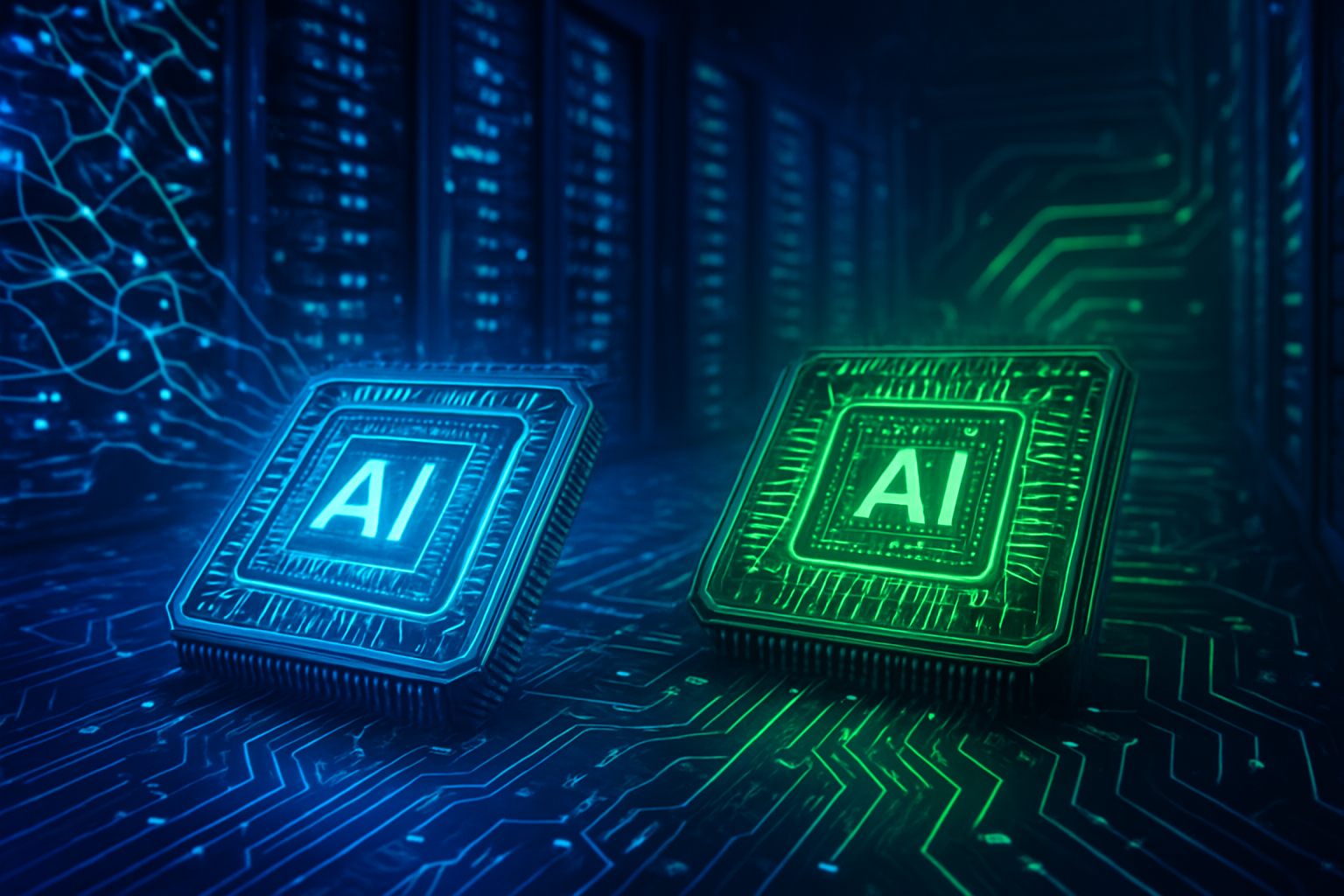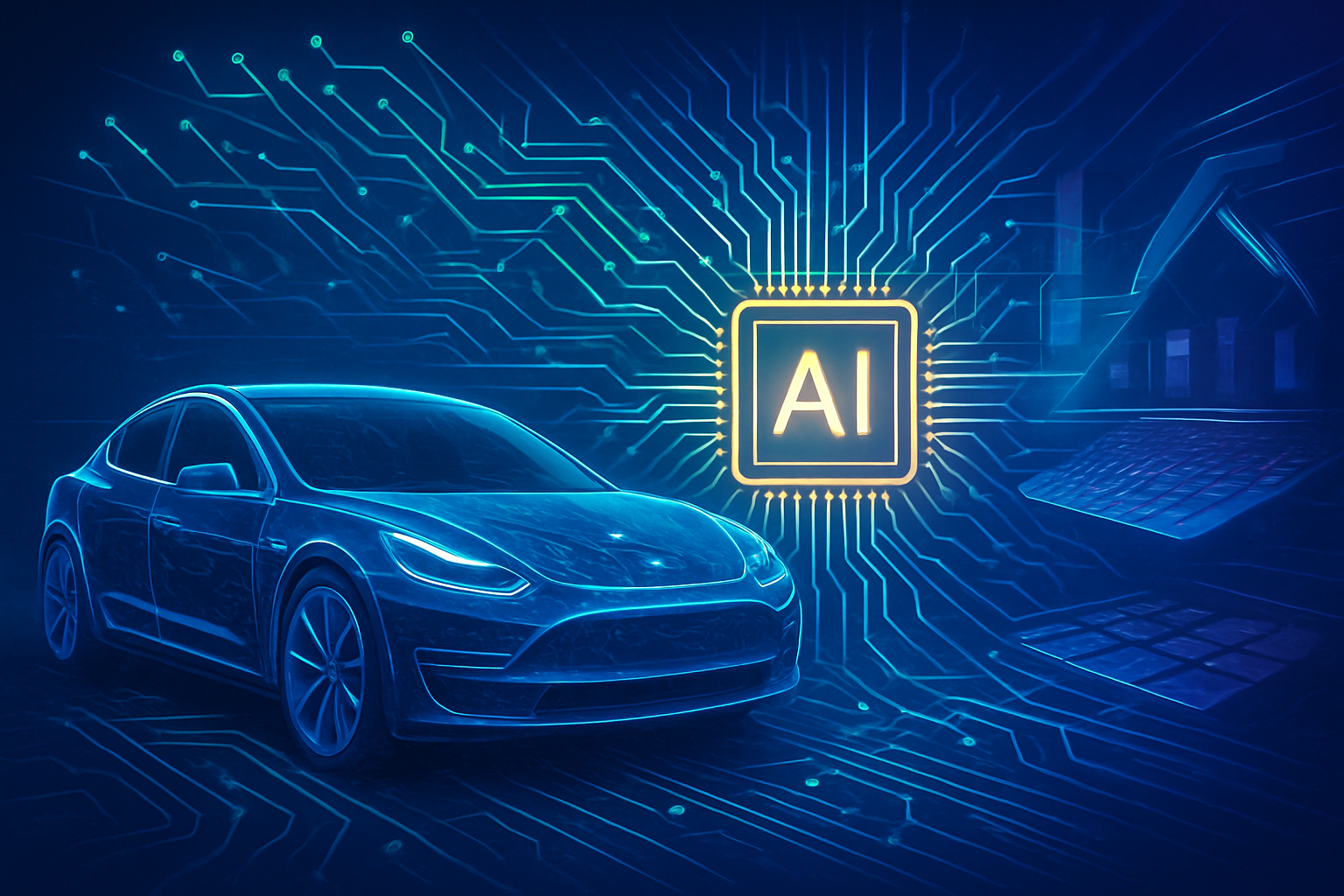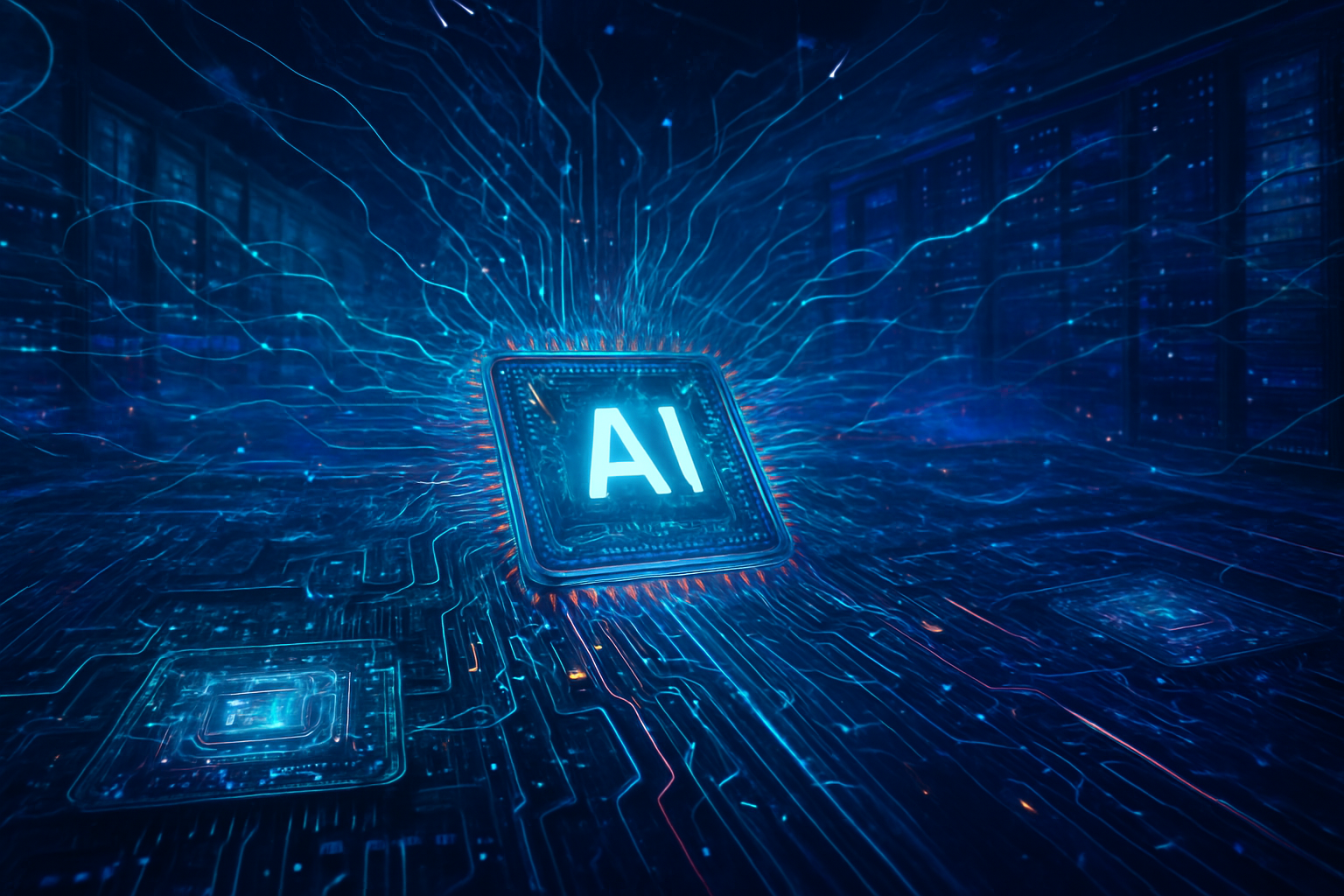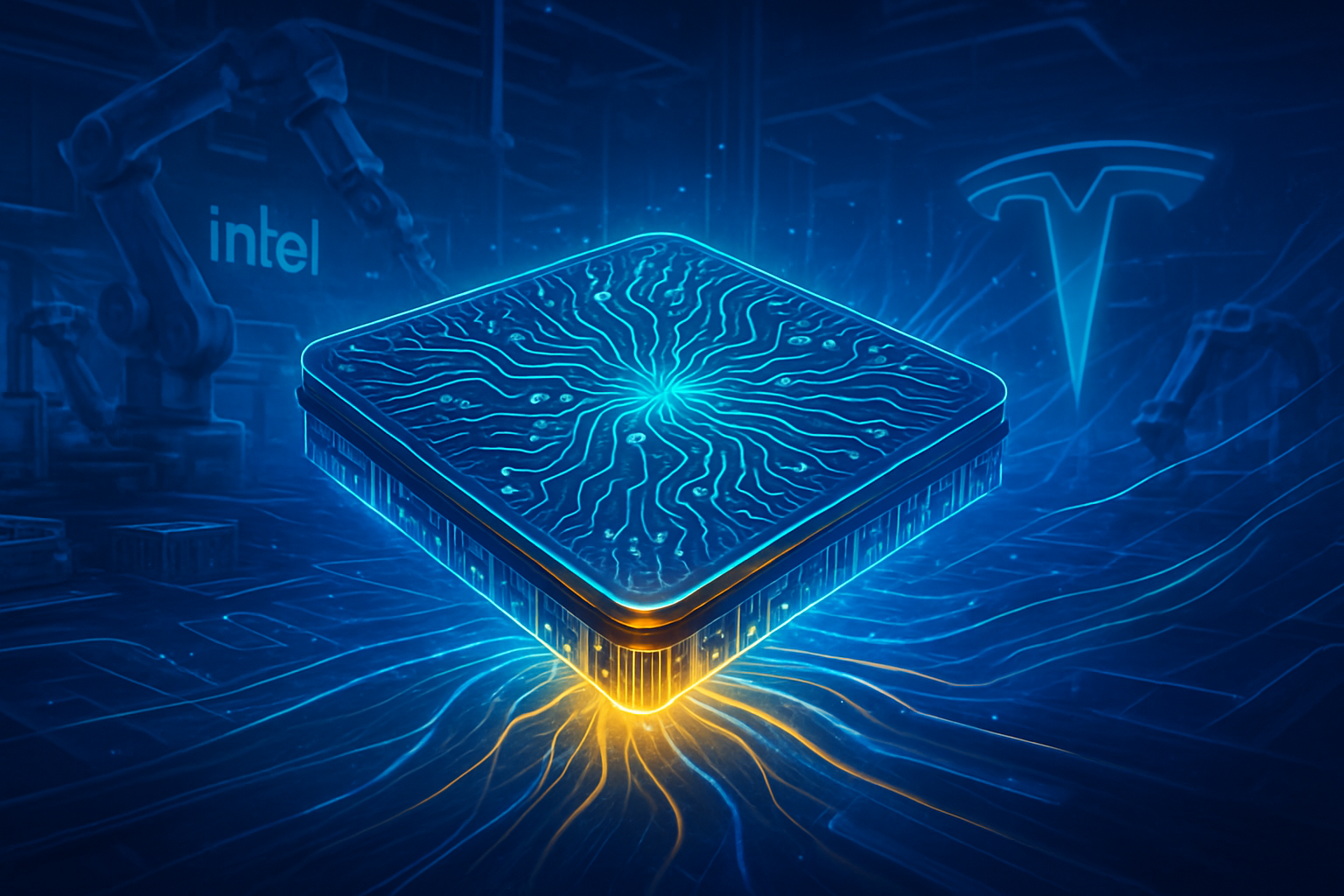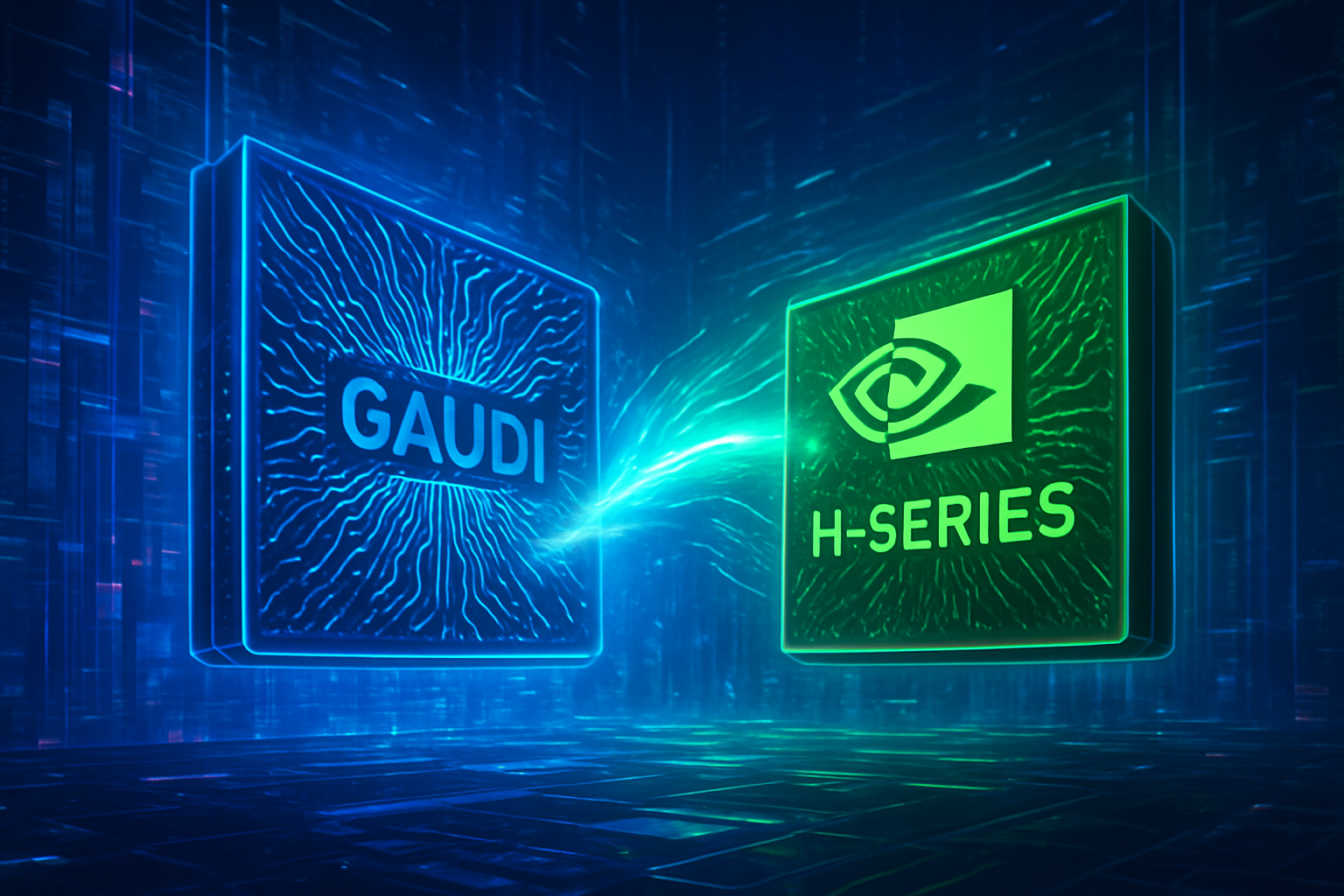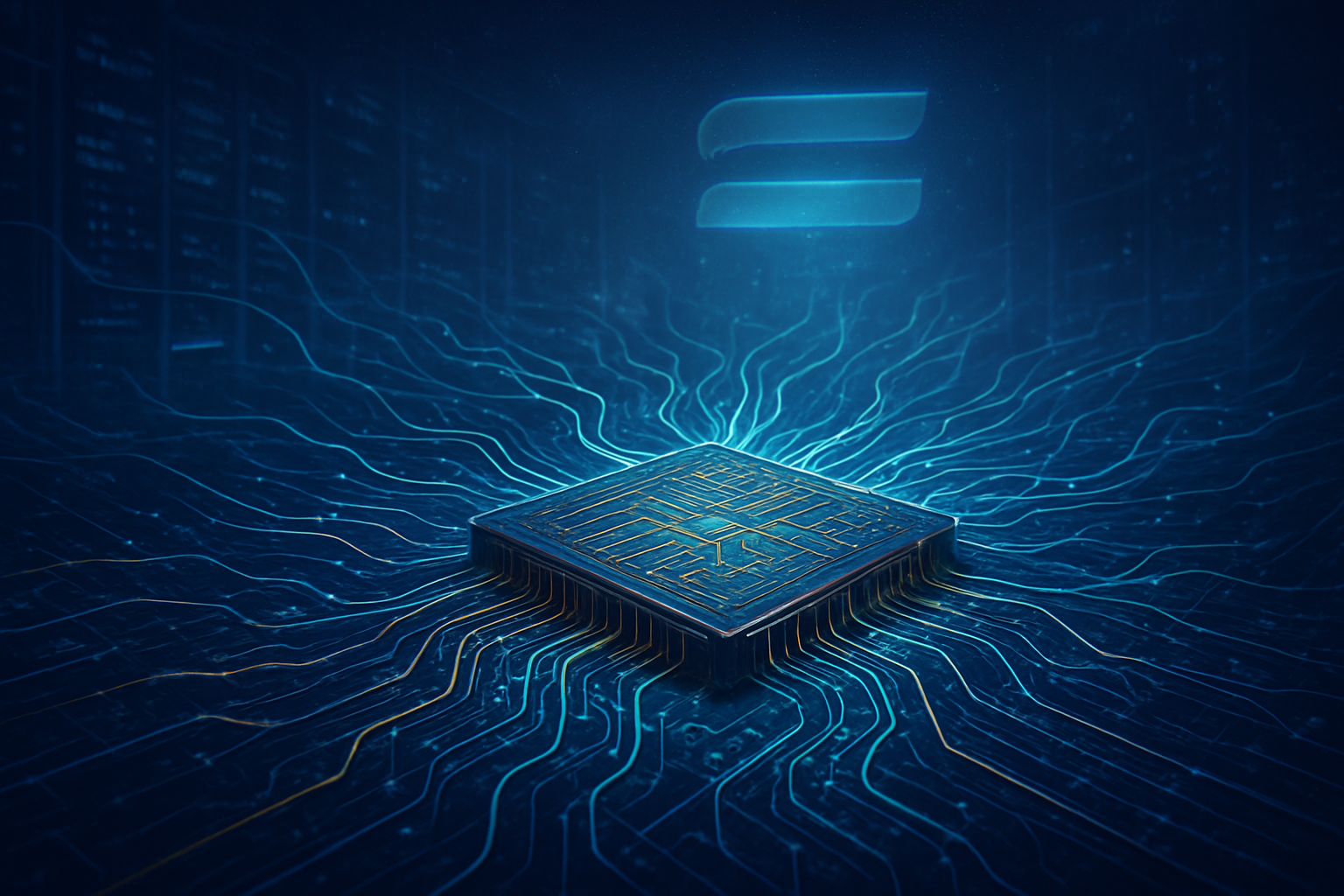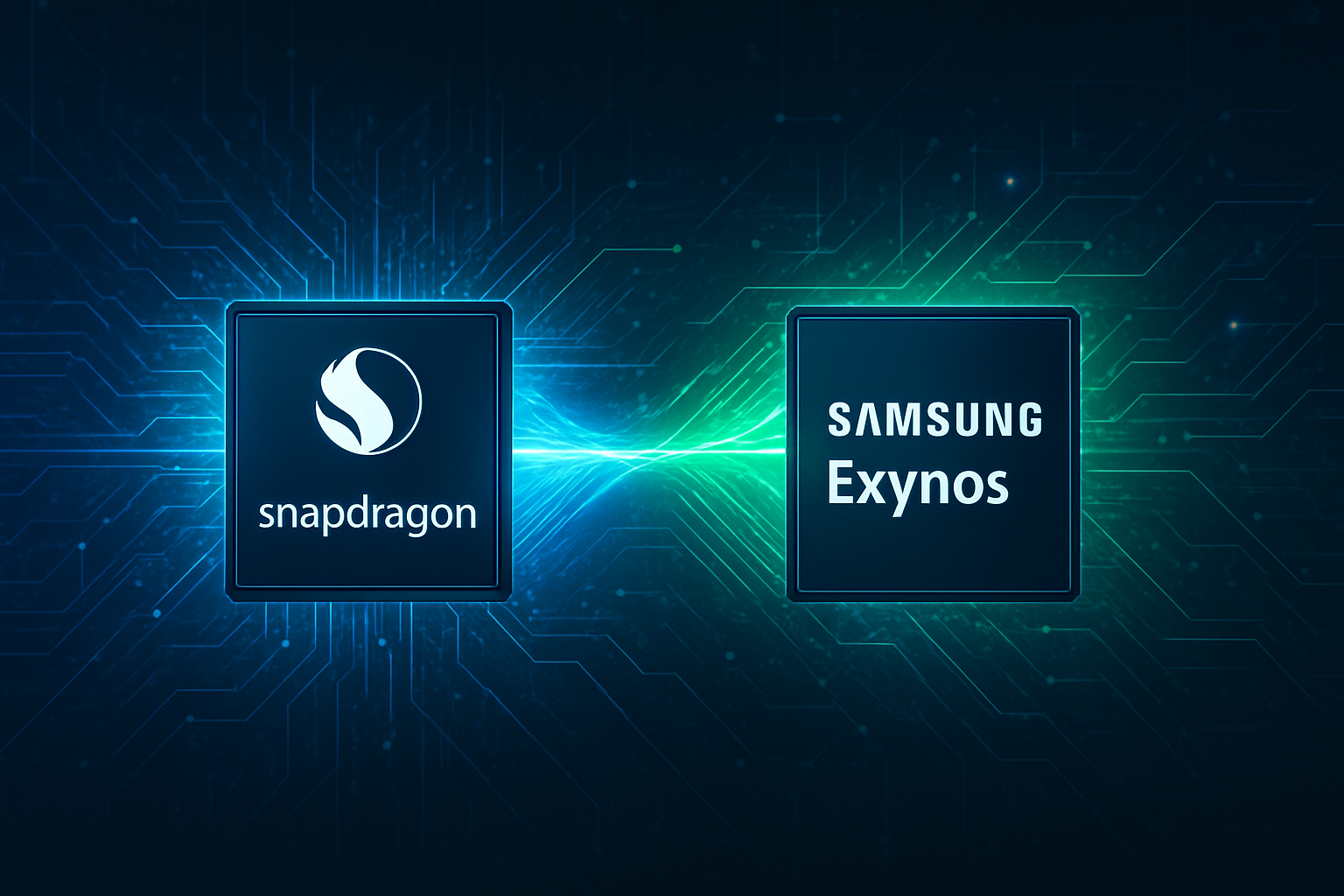The artificial intelligence landscape is witnessing an unprecedented acceleration in hardware innovation, with two industry titans, Nvidia (NASDAQ: NVDA) and Qualcomm (NASDAQ: QCOM), spearheading the charge with their latest AI chip architectures. Nvidia's Blackwell platform, featuring the groundbreaking GB200 Grace Blackwell Superchip and fifth-generation NVLink, is already rolling out, promising up to a 30x performance leap for large language model (LLM) inference. Simultaneously, Qualcomm has officially thrown its hat into the AI data center ring with the announcement of its AI200 and AI250 chips, signaling a strategic and potent challenge to Nvidia's established dominance by focusing on power-efficient, cost-effective rack-scale AI inference.
As of late 2024 and early 2025, these developments are not merely incremental upgrades but represent foundational shifts in how AI models will be trained, deployed, and scaled. Nvidia's Blackwell is poised to solidify its leadership in high-end AI training and inference, catering to the insatiable demand from hyperscalers and major AI labs. Meanwhile, Qualcomm's strategic entry, though with commercial availability slated for 2026 and 2027, has already sent ripples through the market, promising a future of intensified competition, diverse choices for enterprises, and potentially lower total cost of ownership for deploying generative AI at scale. The immediate impact is a palpable surge in AI processing capabilities, setting the stage for more complex, efficient, and accessible AI applications across industries.
A Technical Deep Dive into Next-Generation AI Architectures
Nvidia's Blackwell architecture, named after the pioneering mathematician David Blackwell, represents a monumental leap in GPU design, engineered to power the next generation of AI and accelerated computing. At its core is the Blackwell GPU, the largest ever produced by Nvidia, boasting an astonishing 208 billion transistors fabricated on TSMC's custom 4NP process. This GPU employs an innovative dual-die design, where two massive dies function cohesively as a single unit, interconnected by a blazing-fast 10 TB/s NV-HBI interface. A single Blackwell GPU can deliver up to 20 petaFLOPS of FP4 compute power. The true powerhouse, however, is the GB200 Grace Blackwell Superchip, which integrates two Blackwell Tensor Core GPUs with an Nvidia Grace CPU, leveraging NVLink-C2C for 900 GB/s bidirectional bandwidth. This integration, along with 192 GB of HBM3e memory providing 8 TB/s bandwidth per B200 GPU, sets a new standard for memory-intensive AI workloads.
A cornerstone of Blackwell's scalability is the fifth-generation NVLink, which doubles the bandwidth of its predecessor to 1.8 TB/s bidirectional throughput per GPU. This allows for seamless, high-speed communication across an astounding 576 GPUs, a necessity for training and deploying trillion-parameter AI models. The NVLink Switch further extends this interconnect across multiple servers, enabling model parallelism across vast GPU clusters. The flagship GB200 NVL72 is a liquid-cooled, rack-scale system comprising 36 GB200 Superchips, effectively creating a single, massive GPU cluster capable of 1.44 exaFLOPS (FP4) of compute performance. Blackwell also introduces a second-generation Transformer Engine that accelerates LLM inference and training, supporting new precisions like 8-bit floating point (FP8) and a novel 4-bit floating point (NVFP4) format, while leveraging advanced dynamic range management for accuracy. This architecture offers a staggering 30 times faster real-time inference for trillion-parameter LLMs and 4 times faster training compared to H100-based systems, all while reducing energy consumption per inference by up to 25 times.
In stark contrast, Qualcomm's AI200 and AI250 chips are purpose-built for rack-scale AI inference in data centers, with a strong emphasis on power efficiency, cost-effectiveness, and memory capacity for generative AI. While Nvidia targets the full spectrum of AI, from training to inference at the highest scale, Qualcomm strategically aims to disrupt the burgeoning inference market. The AI200 and AI250 chips leverage Qualcomm's deep expertise in mobile NPU technology, incorporating the Qualcomm AI Engine which includes the Hexagon NPU, Adreno GPU, and Kryo/Oryon CPU. A standout innovation in the AI250 is its "near-memory computing" (NMC) architecture, which Qualcomm claims delivers over 10 times the effective memory bandwidth and significantly lower power consumption by minimizing data movement.
Both the AI200 and AI250 utilize high-capacity LPDDR memory, with the AI200 supporting an impressive 768 GB per card. This choice of LPDDR provides greater memory capacity at a lower cost, crucial for the memory-intensive requirements of large language models and multimodal models, especially for large-context-window applications. Qualcomm's focus is on optimizing performance per dollar per watt, aiming to drastically reduce the total cost of ownership (TCO) for data centers. Their rack solutions feature direct liquid cooling and are designed for both scale-up (PCIe) and scale-out (Ethernet) capabilities. The AI research community and industry experts have largely applauded Nvidia's Blackwell as a continuation of its technological dominance, solidifying its "strategic moat" with CUDA and continuous innovation. Qualcomm's entry, while not yet delivering commercially available chips, is viewed as a bold and credible challenge, with its focus on TCO and power efficiency offering a compelling alternative for enterprises, potentially diversifying the AI hardware landscape and intensifying competition.
Industry Impact: Shifting Sands in the AI Hardware Arena
The introduction of Nvidia's Blackwell and Qualcomm's AI200/AI250 chips is poised to reshape the competitive landscape for AI companies, tech giants, and startups alike. Nvidia's (NASDAQ: NVDA) Blackwell platform, with its unprecedented performance gains and scalability, primarily benefits hyperscale cloud providers like Microsoft (NASDAQ: MSFT), Amazon (NASDAQ: AMZN), Google (NASDAQ: GOOGL), and Meta (NASDAQ: META), who are at the forefront of AI model development and deployment. These companies, already Nvidia's largest customers, will leverage Blackwell to train even larger and more complex models, accelerating their AI research and product roadmaps. Server makers and leading AI companies also stand to gain immensely from the increased throughput and energy efficiency, allowing them to offer more powerful and cost-effective AI services. This solidifies Nvidia's strategic advantage in the high-end AI training market, particularly outside of China due to export restrictions, ensuring its continued leadership in the AI supercycle.
Qualcomm's (NASDAQ: QCOM) strategic entry into the data center AI inference market with the AI200/AI250 chips presents a significant competitive implication. While Nvidia has a strong hold on both training and inference, Qualcomm is directly targeting the rapidly expanding AI inference segment, which is expected to constitute a larger portion of AI workloads in the future. Qualcomm's emphasis on power efficiency, lower total cost of ownership (TCO), and high memory capacity through LPDDR memory and near-memory computing offers a compelling alternative for enterprises and cloud providers looking to deploy generative AI at scale more economically. This could disrupt existing inference solutions by providing a more cost-effective and energy-efficient option, potentially leading to a more diversified supplier base and reduced reliance on a single vendor.
The competitive implications extend beyond just Nvidia and Qualcomm. Other AI chip developers, such as AMD (NASDAQ: AMD), Intel (NASDAQ: INTC), and various startups, will face increased pressure to innovate and differentiate their offerings. Qualcomm's move signals a broader trend of specialized hardware for AI workloads, potentially leading to a more fragmented but ultimately more efficient market. Companies that can effectively integrate these new chip architectures into their existing infrastructure or develop new services leveraging their unique capabilities will gain significant market positioning and strategic advantages. The potential for lower inference costs could also democratize access to advanced AI, enabling a wider range of startups and smaller enterprises to deploy sophisticated AI models without prohibitive hardware expenses, thereby fostering further innovation across the industry.
Wider Significance: Reshaping the AI Landscape and Addressing Grand Challenges
The introduction of Nvidia's Blackwell and Qualcomm's AI200/AI250 chips signifies a profound evolution in the broader AI landscape, addressing critical trends such as the relentless pursuit of larger AI models, the urgent need for energy efficiency, and the ongoing efforts towards the democratization of AI. Nvidia's Blackwell architecture, with its capability to handle trillion-parameter and multi-trillion-parameter models, is explicitly designed to be the cornerstone for the next era of high-performance AI infrastructure. This directly accelerates the development and deployment of increasingly complex generative AI, data analytics, and high-performance computing (HPC) workloads, pushing the boundaries of what AI can achieve. Its superior processing speed and efficiency also tackle the growing concern of AI's energy footprint; Nvidia highlights that training ultra-large AI models with 2,000 Blackwell GPUs would consume 4 megawatts over 90 days, a stark contrast to 15 megawatts for 8,000 older GPUs, demonstrating a significant leap in power efficiency.
Qualcomm's AI200/AI250 chips, while focused on inference, also contribute significantly to these trends. By prioritizing power efficiency and a lower Total Cost of Ownership (TCO), Qualcomm aims to democratize access to high-performance AI inference, challenging the traditional reliance on general-purpose GPUs for all AI workloads. Their architecture, optimized for running large language models (LLMs) and multimodal models (LMMs) efficiently, is crucial for the increasing demand for real-time generative AI applications in data centers. The AI250's near-memory computing architecture, promising over 10 times higher effective memory bandwidth and significantly reduced power consumption, directly addresses the memory wall problem and the escalating energy demands of AI. Both companies, through their distinct approaches, are enabling the continued growth of sophisticated generative AI models, addressing the critical need for energy efficiency, and striving to make powerful AI capabilities more accessible.
However, these advancements are not without potential concerns. The sheer computational power and high-density designs of these new chips translate to substantial power requirements. High-density racks with Blackwell GPUs, for instance, can demand 60kW to 120kW, and Qualcomm's racks draw 160 kW, necessitating advanced cooling solutions like liquid cooling. This stresses existing electrical grids and raises significant environmental questions. The cutting-edge nature and performance also come with a high price tag, potentially creating an "AI divide" where smaller research groups and startups might struggle to access these transformative technologies. Furthermore, Nvidia's robust CUDA software ecosystem, while a major strength, can contribute to vendor lock-in, posing a challenge for competitors and hindering diversification in the AI software stack. Geopolitical factors, such as export controls on advanced semiconductors, also loom large, impacting global availability and adoption.
Comparing these to previous AI milestones reveals both evolutionary and revolutionary steps. Blackwell represents a dramatic extension of previous GPU generations like Hopper and Ampere, introducing FP4 precision and a second-generation Transformer Engine specifically to tackle the scaling challenges of modern LLMs, which were not as prominent in earlier designs. The emphasis on massive multi-GPU scaling with enhanced NVLink for trillion-parameter models pushes boundaries far beyond what was feasible even a few years ago. Qualcomm's entry as an inference specialist, leveraging its mobile NPU heritage, marks a significant diversification of the AI chip market. This specialization, reminiscent of Google's Tensor Processing Units (TPUs), signals a maturing AI hardware market where dedicated solutions can offer substantial advantages in TCO and efficiency for production deployment, challenging the GPU's sole dominance in certain segments. Both companies' move towards delivering integrated, rack-scale AI systems, rather than just individual chips, also reflects the immense computational and communication demands of today's AI workloads, marking a new era in AI infrastructure development.
Future Developments: The Road Ahead for AI Silicon
The trajectory of AI chip architecture is one of relentless innovation, with both Nvidia and Qualcomm already charting ambitious roadmaps that extend far beyond their current offerings. For Nvidia (NASDAQ: NVDA), the Blackwell platform, while revolutionary, is just a stepping stone. The near-term will see the release of Blackwell Ultra (B300 series) in the second half of 2025, promising enhanced compute performance and a significant boost to 288GB of HBM3E memory. Nvidia has committed to an annual release cadence for its data center platforms, with major new architectures every two years and "Ultra" updates in between, ensuring a continuous stream of advancements. These chips are set to drive massive investments in data centers and cloud infrastructure, accelerating generative AI, scientific computing, advanced manufacturing, and large-scale simulations, forming the backbone of future "AI factories" and agentic AI platforms.
Looking further ahead, Nvidia's next-generation architecture, Rubin, named after astrophysicist Vera Rubin, is already in the pipeline. The Rubin GPU and its companion CPU, Vera, are scheduled for mass production in late 2025 and will be available in early 2026. Manufactured by TSMC using a 3nm process node and featuring HBM4 memory, Rubin is projected to offer 50 petaflops of performance in FP4, a substantial increase from Blackwell's 20 petaflops. An even more powerful Rubin Ultra is planned for 2027, expected to double Rubin's performance to 100 petaflops and deliver up to 15 ExaFLOPS of FP4 inference compute in a full rack configuration. Rubin will also incorporate NVLink 6 switches (3600 GB/s) and CX9 network cards (1,600 Gb/s) to support unprecedented data transfer needs. Experts predict Rubin will be a significant step towards Artificial General Intelligence (AGI) and is already slated for use in supercomputers like Los Alamos National Laboratory's Mission and Vision systems. Challenges for Nvidia include navigating geopolitical tensions and export controls, maintaining its technological lead through continuous R&D, and addressing the escalating power and cooling demands of "gigawatt AI factories."
Qualcomm (NASDAQ: QCOM), while entering the data center market with the AI200 (commercial availability in 2026) and AI250 (2027), also has a clear and aggressive strategic roadmap. The AI200 will support 768GB of LPDDR memory per card for cost-effective, high-capacity inference. The AI250 will introduce an innovative near-memory computing architecture, promising over 10 times higher effective memory bandwidth and significantly lower power consumption, marking a generational leap in efficiency for AI inference workloads. Qualcomm is committed to an annual cadence for its data center roadmap, focusing on industry-leading AI inference performance, energy efficiency, and total cost of ownership (TCO). These chips are primarily optimized for demanding inference workloads such as large language models, multimodal models, and generative AI tools. Early deployments include a partnership with Saudi Arabia's Humain, which plans to deploy 200 megawatts of data center racks powered by AI200 chips starting in 2026.
Qualcomm's broader AI strategy aims for "intelligent computing everywhere," extending beyond data centers to encompass hybrid, personalized, and agentic AI across mobile, PC, wearables, and automotive devices. This involves always-on sensing and personalized knowledge graphs to enable proactive, contextually-aware AI assistants. The main challenges for Qualcomm include overcoming Nvidia's entrenched market dominance (currently over 90%), clearly validating its promised performance and efficiency gains, and building a robust developer ecosystem comparable to Nvidia's CUDA. However, experts like Qualcomm CEO Cristiano Amon believe the AI market is rapidly becoming competitive, and companies investing in efficient architectures will be well-positioned for the long term. The long-term future of AI chip architectures will likely be a hybrid landscape, utilizing a mixture of GPUs, ASICs, FPGAs, and entirely new chip architectures tailored to specific AI workloads, with innovations like silicon photonics and continued emphasis on disaggregated compute and memory resources driving efficiency and bandwidth gains. The global AI chip market is projected to reach US$257.6 billion by 2033, underscoring the immense investment and innovation yet to come.
Comprehensive Wrap-up: A New Era of AI Silicon
The advent of Nvidia's Blackwell and Qualcomm's AI200/AI250 chips marks a pivotal moment in the evolution of artificial intelligence hardware. Nvidia's Blackwell platform, with its GB200 Grace Blackwell Superchip and fifth-generation NVLink, is a testament to the pursuit of extreme-scale AI, delivering unprecedented performance and efficiency for trillion-parameter models. Its 208 billion transistors, advanced Transformer Engine, and rack-scale system architecture are designed to power the most demanding AI training and inference workloads, solidifying Nvidia's (NASDAQ: NVDA) position as the dominant force in high-performance AI. In parallel, Qualcomm's (NASDAQ: QCOM) AI200/AI250 chips represent a strategic and ambitious entry into the data center AI inference market, leveraging the company's mobile DNA to offer highly energy-efficient and cost-effective solutions for large language models and multimodal inference at scale.
Historically, Nvidia's journey from gaming GPUs to the foundational CUDA platform and now Blackwell, has consistently driven the advancements in deep learning. Blackwell is not just an upgrade; it's engineered for the "generative AI era," explicitly tackling the scale and complexity that define today's AI breakthroughs. Qualcomm's AI200/AI250, building on its Cloud AI 100 Ultra lineage, signifies a crucial diversification beyond its traditional smartphone market, positioning itself as a formidable contender in the rapidly expanding AI inference segment. This shift is historically significant as it introduces a powerful alternative focused on sustainability and economic efficiency, challenging the long-standing dominance of general-purpose GPUs across all AI workloads.
The long-term impact of these architectures will likely see a bifurcated but symbiotic AI hardware ecosystem. Blackwell will continue to drive the cutting edge of AI research, enabling the training of ever-larger and more complex models, fueling unprecedented capital expenditure from hyperscalers and sovereign AI initiatives. Its continuous innovation cycle, with the Rubin architecture already on the horizon, ensures Nvidia will remain at the forefront of AI computing. Qualcomm's AI200/AI250, conversely, could fundamentally reshape the AI inference landscape. By offering a compelling alternative that prioritizes sustainability and economic efficiency, it addresses the critical need for cost-effective, widespread AI deployment. As AI becomes ubiquitous, the sheer volume of inference tasks will demand highly efficient solutions, where Qualcomm's offerings could gain significant traction, diversifying the competitive landscape and making AI more accessible and sustainable.
In the coming weeks and months, several key indicators will reveal the trajectory of these innovations. For Nvidia Blackwell, watch for updates in upcoming earnings reports (such as Q3 FY2026, scheduled for November 19, 2025) regarding the Blackwell Ultra ramp and overall AI infrastructure backlog. The adoption rates by major hyperscalers and sovereign AI initiatives, alongside any further developments on "downgraded" Blackwell variants for the Chinese market, will be crucial. For Qualcomm AI200/AI250, the focus will be on official shipping announcements and initial deployment reports, particularly the success of partnerships with companies like Hewlett Packard Enterprise (HPE) and Core42. Crucially, independent benchmarks and MLPerf results will be vital to validate Qualcomm's claims regarding capacity, energy efficiency, and TCO, shaping its competitive standing against Nvidia's inference offerings. Both companies' ongoing development of their AI software ecosystems and any new product roadmap announcements will also be critical for developer adoption and future market dynamics.
This content is intended for informational purposes only and represents analysis of current AI developments.
TokenRing AI delivers enterprise-grade solutions for multi-agent AI workflow orchestration, AI-powered development tools, and seamless remote collaboration platforms.
For more information, visit https://www.tokenring.ai/.
